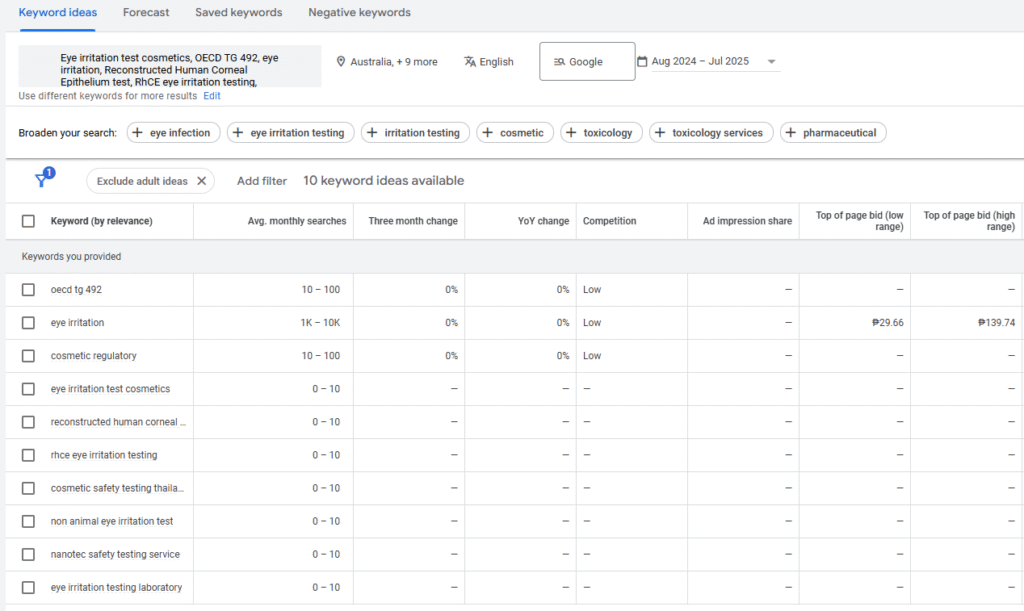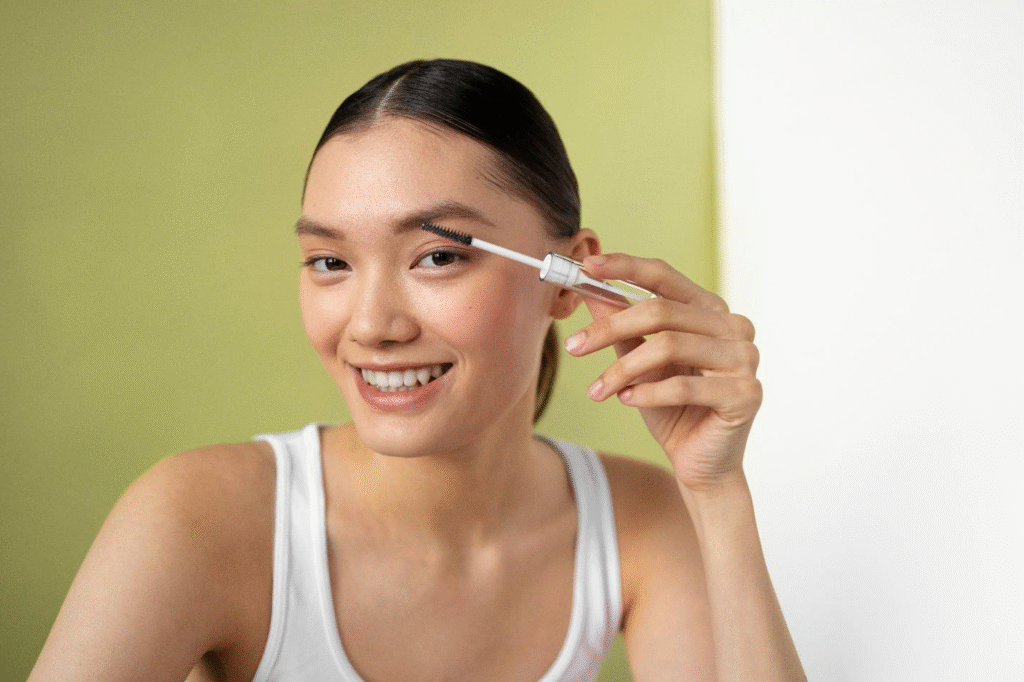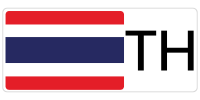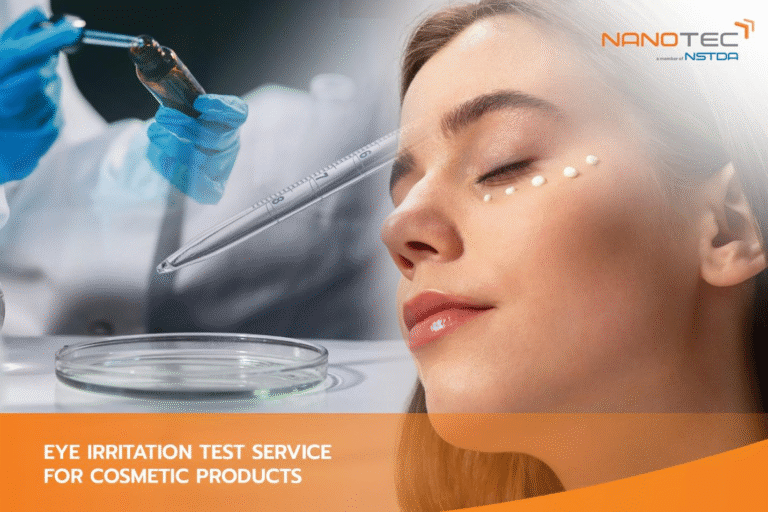Meta Description: Eye Irritation Test (OECD TG 492) for cosmetics by NANOTEC. Non-animal RhCE model, international standard safety testing, expert consultation, and reliable results for regulatory approval and consumer trust.
SEO Keywords: Eye irritation test cosmetics, OECD TG 492, eye irritation, Reconstructed Human Corneal Epithelium test, RhCE eye irritation testing, Cosmetic safety testing Thailand, Non-animal eye irritation test, NANOTEC safety testing service, Cosmetic regulatory, Eye irritation testing laboratory, Safety and efficacy testing for cosmetics

Ensuring the safety of cosmetic and personal care products is a fundamental requirement for both regulatory compliance and consumer trust. Among the most sensitive aspects of product safety is eye compatibility, as irritation to the eyes can lead to discomfort, consumer dissatisfaction, and potential market withdrawal. For companies developing cosmetics, cosmeceuticals, and health products, having reliable safety test data is essential to building brand credibility and gaining regulatory acceptance.
The National Nanotechnology Center (NANOTEC), under the National Science and Technology Development Agency (NSTDA), offers specialized safety and efficacy testing services, including the Eye Irritation Test. This service uses internationally recognized non-animal testing methods to determine whether a substance or finished product causes irritation or injury to the eye.
By providing scientifically validated results that align with global testing standards, NANOTEC supports manufacturers and product developers in achieving regulatory approval, strengthening consumer confidence, and creating a competitive advantage in the marketplace.

What is the Eye Irritation Test?
The Eye Irritation Test evaluates the potential of a chemical or cosmetic product to cause adverse effects when it comes in contact with the eye. Traditionally, this type of testing was performed using live animals, raising ethical concerns and facing increasing regulatory restrictions worldwide.
Today, NANOTEC utilizes a Reconstructed Human Corneal Epithelium (RhCE) model, which closely mimics the biological and structural characteristics of the human eye’s outer surface, specifically the corneal and conjunctival tissue. This model has been validated and accepted by The European Centre for the Validation of Alternative Methods (ECVAM) and is included in the OECD Test Guideline 492 (OECD TG 492) as a standard method for eye irritation assessment.
The principle of the test involves:
- Exposing RhCE tissues to the test substance.
- Measuring the percentage of cell viability after exposure.
- Interpreting results to classify the substance as non-irritant (No Category) or irritant (Category 2) according to the UN Globally Harmonized System of Classification and Labelling of Chemicals (GHS).
This scientifically robust method eliminates the use of experimental animals while delivering accurate, reproducible, and internationally accepted results.
Importance of Eye Irritation Testing in Cosmetics
Cosmetic products often come into direct or indirect contact with the eye area. Ingredients in cleansers, shampoos, facial creams, and makeup can accidentally migrate into the eyes during use. Without proper safety evaluation, these products may cause redness, stinging, tearing, or more severe injuries.
Regulatory Compliance
- International Standards: Eye irritation testing according to OECD TG 492 is accepted by regulatory agencies worldwide, including the European Union, the U.S. Food and Drug Administration (FDA), and the ASEAN Cosmetic Directive.
- Market Access: Compliance with recognized test guidelines allows cosmetic products to be marketed in regions with strict safety requirements, avoiding delays or product rejections.
Consumer Safety and Confidence
- Protecting Sensitive Organs: The human eye is one of the most delicate and sensitive organs. Reliable safety testing ensures that products used around the eye area are safe and do not cause harm.
- Building Brand Trust: Demonstrating validated safety test results helps companies gain consumer trust and strengthen brand reputation.
Market Competitiveness
- Products backed by safety and efficacy data stand out in a competitive market. Test results can be used in marketing claims, technical dossiers, and communication with business partners.
NANOTEC’s Eye Irritation Test Service
NANOTEC provides comprehensive eye irritation testing for cosmetic products and ingredients with a strong emphasis on scientific validity, regulatory compliance, and ethical responsibility.
Key Highlights of the Service
- Non-Animal Testing
- The method is based on the Reconstructed Human Corneal Epithelium (RhCE) model, ensuring that no animals are used.
- This aligns with the 3Rs principle (Replacement, Reduction, Refinement) in scientific research.
- International Standard (OECD TG 492)
- Conducted under OECD-approved test guidelines to ensure acceptance by regulatory authorities worldwide.
- Expert Guidance
- NANOTEC’s team of specialists provides consultation on experimental design to ensure the method suits each product’s unique formulation and application.
- Market Advantage
- Safety testing data enhances credibility and allows companies to make evidence-based claims on product safety, supporting both regulatory submissions and marketing strategies.
Methodology in Detail
Step 1: Sample Preparation
- Products or raw materials submitted for testing must meet the required quantity and format.
- NANOTEC accepts up to two samples per submission batch under this service.
Step 2: Exposure on RhCE Model
- Samples are applied to the 3D tissue model that replicates the human corneal epithelium.
- After a defined exposure period, tissues are rinsed to remove test material.
Step 3: Measurement of Tissue Viability
- Tissue viability is assessed using biochemical assays (such as MTT-based methods).
- Results are compared with control groups.
Step 4: Data Interpretation
- ≥ 60% cell viability: Classified as Non-Irritant (No Category).
- < 60% cell viability: Classified as Irritant (Category 2).
Step 5: Reporting
- Clients receive a comprehensive report detailing the methodology, results, classification, and interpretation in line with OECD TG 492 guidelines.
Pricing Information
| Test | Description | Price (THB)* | Unit | Remark |
| Eye Irritation Test | OECD TG 492 method using RhCE model | 95,000 | 1–2 samples | Maximum submission: 2 samples |
*Price excludes VAT
This transparent pricing structure makes it easy for clients to plan their safety testing budget effectively.
Applications Across Industries
While primarily intended for cosmetic and cosmeceutical products, the Eye Irritation Test is also relevant for other sectors:
- Personal Care Products: Shampoos, conditioners, facial cleansers, makeup, sunscreens.
- Raw Materials and Ingredients: Botanical extracts, synthetic compounds, preservatives, surfactants.
- Health Products: Products with topical applications near the eye area.
By covering both finished products and raw ingredients, NANOTEC’s service supports companies at all stages of product development from R&D to market launch.
Why Choose NANOTEC?
- National Research Authority
- As part of NSTDA, NANOTEC is a recognized leader in nanotechnology and applied science, with strong credibility in both research and industry collaboration.
- Cutting-Edge Facilities
- Equipped with advanced laboratories and internationally validated testing systems.
- Experienced Team
- Multidisciplinary experts in toxicology, nanotechnology, and cosmetic science provide guidance tailored to your product.
- Compliance and Acceptance
- Test reports align with OECD TG 492 and can be used for regulatory submissions, product registration, and marketing claims across global markets.
- Ethical Responsibility
- The method avoids animal testing, aligning with global consumer demand for cruelty-free products.
How the Service Benefits Your Business
- Accelerated Market Entry: Smooth regulatory approvals with OECD-standard safety data.
- Improved Consumer Confidence: Build trust with consumers through validated safety claims.
- Differentiation: Use safety test reports to distinguish your products in the competitive cosmetic industry.
- Risk Reduction: Prevent costly recalls, negative consumer feedback, or compliance failures by ensuring product safety before launch.
Contact NANOTEC for Eye Irritation Test Services
For companies developing cosmetics, cosmeceuticals, and health products, the Eye Irritation Test service by NANOTEC offers a reliable, ethical, and internationally accepted solution to product safety evaluation.
To inquire about testing, sample submission, or consultation, please contact:Infrastructure Services
National Nanotechnology Center (NANOTEC)
143 INC 2 (B), Thailand Science Park, Phahonyothin Road, Khlong Nueng, Khlong Luang, Pathum Thani 12120
Tel. +66 2 564 7100 ext. 6517, 6625, 6680
Email: bdis-infs@nanotec.or.th


